Type Streetcar Termini Grand
Congress Locale Detroit | Status Under construction Daily ridership 5,400 (forecast) | |
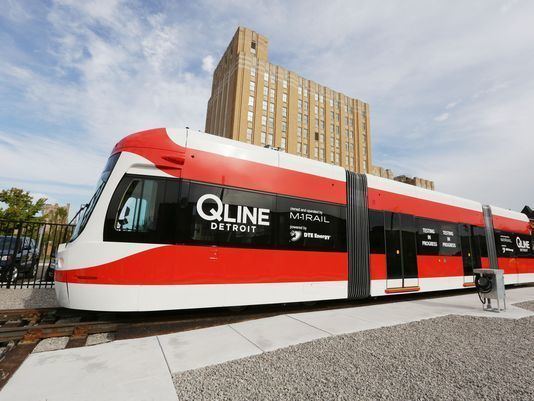 | ||
Stations 20 stops (12 locations) Planned opening May 12, 2017 (2017-05-12) | ||
Qline will stay open late on weekends report says
The QLine (stylized as QLINE), originally known as M-1 Rail by its developers and the Woodward Avenue Streetcar by the Michigan Department of Transportation (MDOT), is a streetcar line under construction, to run along M-1 (Woodward Avenue) in Detroit, Michigan. Quicken Loans bought the naming rights to the line, and announced the name in March 2016. In December 2011, city and state leaders announced a plan to offer bus rapid transit service for the city and metropolitan area instead of light rail as had previously been proposed. Soon afterwards, M-1 Rail, a consortium of private and public businesses and institutions in the region, announced the plan for a 3.3-mile-long (5.3 km) streetcar line along part of the same route as the cancelled light rail plan, connecting the downtown Detroit People Mover to the railway station in New Center which serves Amtrak and the proposed SEMCOG commuter rail system. The opening is targeted for May 12, 2017.
Contents
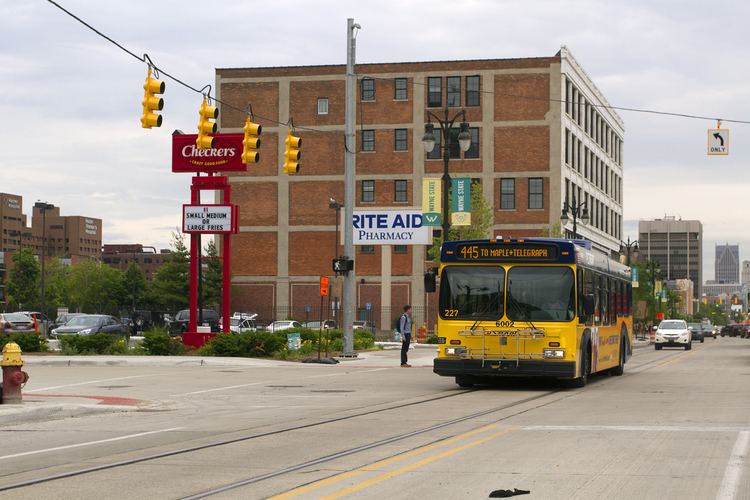
History

Detroit's first streetcar service began in 1863 with horsecars. Electrification of the streetcar system followed, starting in 1886. Detroit's streetcar lines eventually saw their operations consolidated under the privately owned Detroit United Railway. Municipal takeover and control of the streetcar network by Detroit's Department of Street Railways followed in 1922. But the Department of Street Railways' introduction of buses (starting in 1925) ultimately led to the demise of the original streetcar system in 1956.
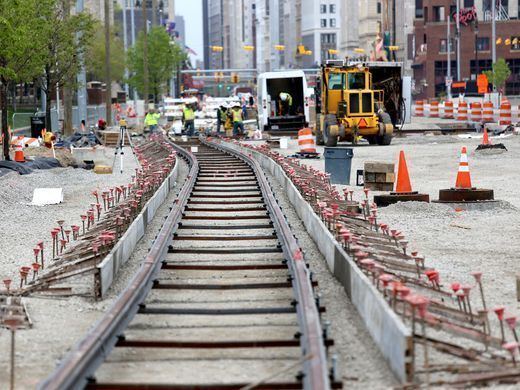
Planning for the return of rapid transit to Detroit began in 2006 when the Detroit Department of Transportation (DDOT) commissioned a study to determine expanded mass transit options along Woodward Avenue. Concurrently, a private group of local business leaders decided to provide matching funds to government dollars to develop a $125 million, 3.4-mile (5.5 km) line through central Detroit (similar to the Tacoma Link) called the M-1 Rail Line. After much wrangling between the private investors and the DDOT, the two groups decided to work in tandem on developing DDOT's 9.3-mile (15.0 km) line.

The proposed line ran 9.3 miles (15.0 km) along Woodward Avenue from the Rosa Parks Transit Center to the old State Fairgrounds along 8 Mile Road. The line would have had 19 stops with 10 cars running at a time in two-car trains; each train would carry 150 people. The trains would run in a dedicated right-of-way in the median from 8 Mile to Adams Street at the north end of downtown. South of Adams, the trains would run in traffic along the sides of the street.
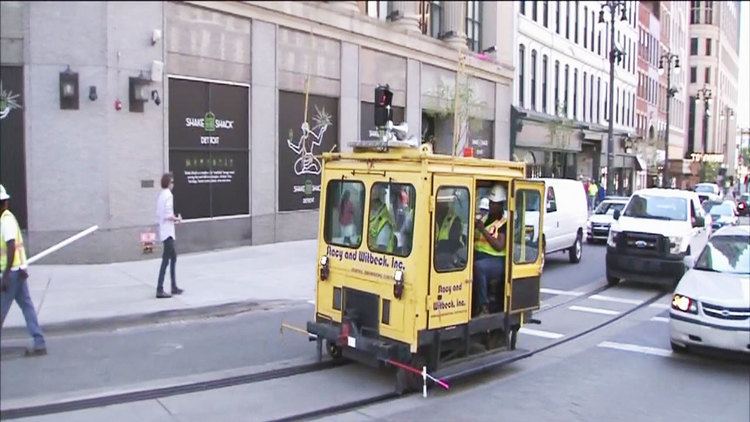
The estimated cost for the proposed line was $500 million. The Kresge Foundation awarded a $35 million grant to the city for the project in March 2009. It received $25 million in funding from the United States Department of Transportation in February 2010. The Detroit City Council approved the sale of $125 million in bonds on April 11, 2011. The Federal Transit Administration (FTA) and the City of Detroit signed an environmental impact study on July 1, 2011. Finally, on August 31, 2011, the FTA signed a record of decision allowing the project to move forward.
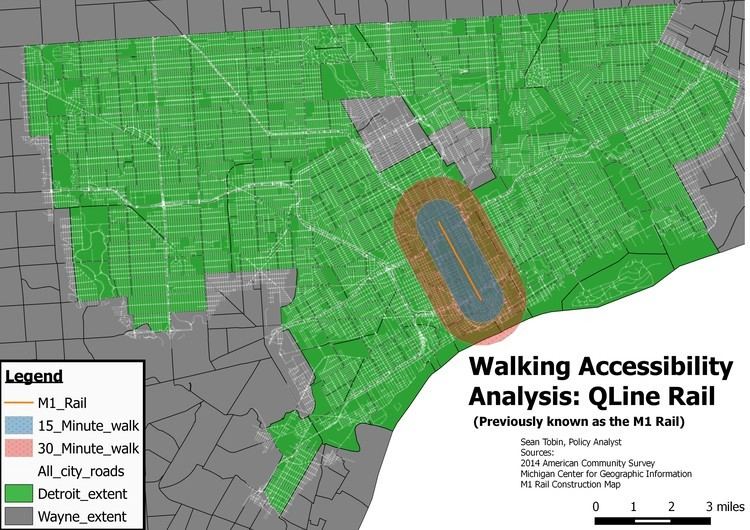
In December 2011 the federal government withdrew its support for the proposed line, in favor of a bus rapid transit system which would serve the city and suburbs. This decision arose out of discussions between federal Secretary of Transportation Ray LaHood, Detroit Mayor Dave Bing and Governor Rick Snyder. The private investors who had initially supported the smaller three-mile (4.8 km) M-1 Rail line to New Center stated that they would continue developing that project through the nonprofit M-1 Rail Consortium.
Construction
On January 18, 2013, U.S. Department of Transportation Secretary Ray LaHood announced that M-1 Rail would receive $25 million in federal grant support for the streetcar project. He had previously committed to the funds on the condition that a regional transit authority was created for the Detroit area. In late 2012, the Regional Transit Authority of Southeast Michigan was created by state law, which enabled LaHood's approval.
On April 22, 2013, the project received final environmental clearance from the federal government, with construction expected to start in the fall.
On December 20, 2013, M-1 Rail began underground utility relocation work along Woodward Avenue, the first step toward full-fledged construction activities of the 3.3-mile (5.3 km) streetcar line, with construction scheduled to start in mid-2014. Stacy & Witbeck were formally awarded the contract to construct the M-1 Rail streetcar line on July 31, 2013. M-1 Rail officials announced on July 3, 2014, that the Woodward Avenue overpasses for both I-75 and I-94 freeways will be demolished during construction of the rail line, and that new wider bridges will be built.
On July 20, 2014, the Ilitch family, owner of Olympia Development of Michigan, and major investor in M-1 Rail, announced that the streetcar line will include a stop at the new $450 million Detroit Red Wings arena in Midtown, when construction is completed in mid-2017.
M-1 Rail officially started construction on July 28, 2014. The streetcar line will stretch from downtown Detroit to Grand Boulevard in New Center. There will be 20 different stations serving 12 stops, with most of the stations being curbside on either side of Woodward Avenue going uptown or downtown, but changing to center road stations at the north and south ends of the system. At the time, the streetcar line was expected to be operational in late 2016.
On September 9, 2014, the US DOT announced that M-1 Rail would receive an additional $12.2 million in federal grant money to complete the financing of the M-1 Rail project. US Transportation Secretary Anthony Foxx gave the keynote address at a rail signing ceremony on September 15, 2014 at Grand Circus Park. Local officials were in attendance as were executives of local businesses who were sponsoring stations near their places of business. A new official map was made public.
Approximately 60 percent of the line will not be equipped with overhead electrical wires, and the streetcars will be powered solely from lithium-ion batteries on that section.
On February 15, 2015, M-1 Rail reported that the Penske Tech Center was under construction in New Center. The $6.9 million, 19,000-square-foot (1,800 m2) structure will serve as the M-1 Rail headquarters, the operations center, and the streetcar maintenance facility. The tech center building will be sited close to Woodward Avenue, and located between Bethune and Custer streets north and east of Grand Boulevard with the streetcar storage yard behind. The exterior will be made of reddish brick to mimic the historical look and feel of the surrounding neighborhood, and was completed in May 2016.
In August 2015, M-1 Rail officials said that the opening of the line would be delayed until around mid 2017, partially because of new federal safety standards that are coming into effect, as well as a construction slowdown during the previous winter and delays in building the rolling stock. QLine was announced as the official name for the line in March 2016, after Quicken Loans bought naming rights, but the non-profit organization that is overseeing the project continues to be named M-1 Rail.
The first streetcar was delivered in September 2016. The first test move over the line took place on December 13, and the streetcar was initially towed (not yet run under its own power, except at the maintenance facility). As of early December 2016, most construction work had been completed, but work was continuing on the stations, and the opening of the system was targeted for the second quarter of 2017.
Rolling stock
Crain's Detroit Business reported that the line would cost $137 million, including the purchase of six streetcar vehicles. Bids were expected to include low-floor, air-conditioned vehicles, capable of transporting passengers in wheelchairs. The vehicles will have operator's controls at both ends—eliminating the need for the vehicles to turn around for their return trips.
On November 4, 2014, M-1 announced that Czech-based Inekon had been awarded a $30 million contract for six vehicles. Upon that deal falling apart, M-1 Rail instead awarded a $32 million contract to Pennsylvania-based Brookville Equipment Corporation. The purchase includes six articulated, three-section, 66-foot-long (20 m) cars, equipped with 750-volt rechargeable lithium-ion batteries for off-wire movement on sections of the line not equipped with overhead wire.
The first Brookville-built streetcar was delivered in September 2016. Three of the six cars had been delivered by early December, and delivery of the remaining cars is projected to be completed by the end of January. The last car of Detroit's previous streetcar system was numbered 286, so it was decided to number the new cars 287–292, to pick up where the old number series had left off.
